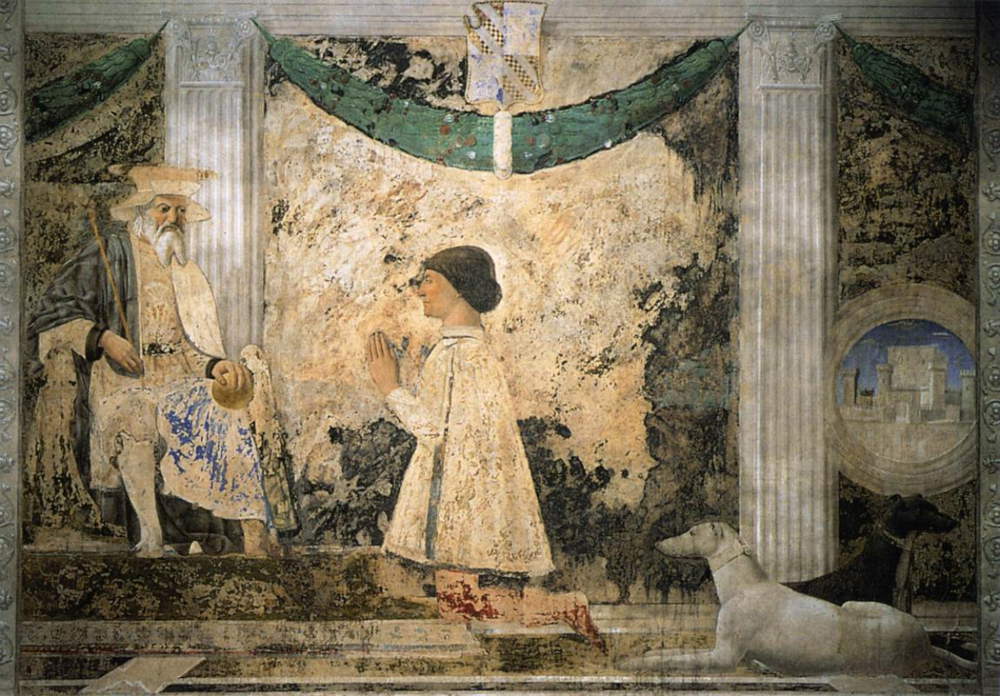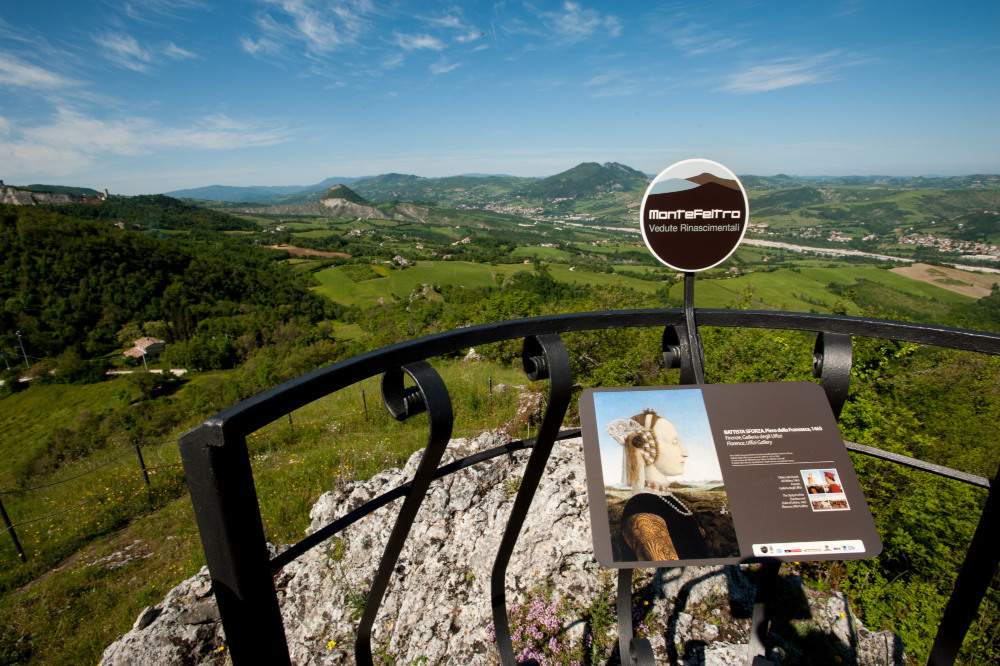Renaissance in Romagna: on the trail of Piero della Francesca and Leon Battista Alberti between Rimini and Ferrara
To follow in the footsteps of two great protagonists of the Italian Renaissance such as Leon Battista Alberti and Piero della Francesca in order to explore in Romagna the historical-artistic and intellectual heritage that these artists left us: this is the objective of the Leon Battista Alberti and Piero della Francescaitinerary. The Rebirth of the Arts between Ferrara and Rimini, which winds its way through the two cities that were the fulcrum in the Renaissance of two important courts: the Este court in Ferrara and the Malatesta court in Rimini.
In Ferrara, Piero della Francescaworked at the court of Marquis Leonello d’Este, half-brother of Borso d’Este, to create frescoes, now lost, in the Castle of San Michele and the church of Sant’Andrea. The latter became during the Este seigniory one of the most important churches in the city; Biagio Rossetti, Alberto Schiatti, Giovan Battista Aleotti and Giuseppe Mazzuoli known as Bastarolo were buried there. Reduced to its present state by collapses and demolitions during the 20th century, it was a parish church until 1806, while in Napoleonic times it was used as a barracks. It was closed to worship in 1866 and completely emptied of paintings and furnishings received over the years from donations. È however, it is possible to see works of art from the church of Sant’Andrea in the National Picture Gallery of Ferrara, such as the frescoes with the Triumph of St. Augustine and St. Dorothy being led to martyrdom attributed to Serafino de’ Serafini and dating from around 1378, the polyptych Costabili made by Benvenuto Tisi known as Garofalo and Dosso Dossi between about 1513 and 1525, and again, the detached fresco with theOld and New Testament (1523) by Garofalo from the monastery refectory.
Other significant artworks currently on view at the Casa Romei Museum come from the church of St. Andrew: a sculpture depicting St. Nicholas of Tolentino attributed to Alfonso Lombardi, a St. Michael the Archangel by Andrea Ferreri, fragments of 13th-century frescoes depicting the Virgin Annunciate and the Announcing Angel with a saint, and two frescoes by an anonymous painter of the Ferrara school from the early 16th century depicting St. James of the Marches and St. Augustine. In the castle, on the other hand, Piero della Francesca painted, as stated by Vasari, “many rooms that were then ruined by Duke Ercole the Elder in order to reduce the palace to the modern.” This was 1448-1449. Then in 1451 the artist arrived in Rimini, called by Sigismondo Pandolfo Malatesta, to create one of his masterpieces inside the Malatesta Temple(you can read our article dedicated to the Malatesta Temple here). In fact, one can still admire thefresco depicting Sigismondo Malatesta kneeling before his patron saint Sigismondo, a very significant work both for Rimini and for the artist himself, since it is the first fully Renaissance pictorial work, in a context still linked to courtly Gothic, as well as the highest moment of the Renaissance of central Italian matrix. It is also theonly dated work by Piero in the Emilia-Romagna territory and thus evidence of the period linked to the Malatesta court.
GAL Montefeltro Sviluppo and the Emilia-Romagna Region, in collaboration with landscape architect Carlo Leonardi, have also devised the project Balconies of Piero in Montefeltro, through which it is possible to rediscover the exact landscapes and views that served as the backdrop for famous works by the artist, such as The Baptism of Christ, The Resurrection, The Nativity, Portrait of Battista Sforza, St. Jerome and a Devotee. These landscapes were believed to be imaginary until 2007, but some scholars have identified them. They are examples of Piero’s Balconies in Romagna Montecopiolo-Monte Palazzolo, which allegedly inspired Piero Della Francesca for his Nativity, and also in Montecopiolo, in the locality of Pugliano, one would find instead the landscape that inspired the Resurrection. In Sant’Agata Feltria, in the locality of Petrella Guidi, the background of the Baptism of Christ; in San Leo that of Saint Jerome and a devotee; and in Poggio Torriana, in the locality of Montebello, that of the Portrait of Battista Sforza.
The Malatesta Temple owes its exterior appearance to Leon Battista Alberti, who beginning in 1453 began to arrange the exterior of theancient church of San Francesco, a Gothic basilica with a single nave and side chapels: the task had been entrusted to him by Sigismondo Malatesta, lord of Rimini and Fano from 1432. Leon Battista Alberti designed an innovative temple: he used the typical structure of theRoman triumphal arch for the façade, drawing inspiration from theArch of Augustus in Rimini, and, as in an ancient temple, he also inserted a frieze with the inscription SIGISMUNDUS PANDULFUS MALATESTA PANDVLFI F V FECIT ANNO GRATIAE MCCCCL, or “Sigismondo Pandolfo Malatesta, son of Pandolfo, realized by vow in the year of grace 1450.” The monument was to have been completed, according to the architect’s plan, with the insertion of a majestic rotunda crowned with a dome taken from the Pantheon in Rome, but the project remained unfinished with the death of Sigismondo Malatesta in 1468, although work had already stopped at the time of the clashes with Pius II. A medal by Matteo de’ Pasti, Alberti’s collaborator in Rimini, on which the complete design of the Malatesta Temple with the planned dome can be seen, is preserved in the Museum of the City of Rimini.
But Leon Battista Alberti was also linked to Ferrara thanks to Leonello d’Este, prince and lord of the city between 1441 and 1450. Indeed, Alberti’s treatise Theogenius and De equo animante were dedicated to the latter. Alberti was also involved as referee in the competition called by the Collegio dei Savi in 1443 for the sketch of the equestrian statue of Niccolò III, although the choice later fell to Niccolò Baroncelli and Antonio di Cristoforo for the bronze effigy of the knight. Finally, the bell tower of Ferrara Cathedral, built starting in 1412 and finished in several stages between 1451 and 1487, would also probably be linked to the figure of Leon Battista Alberti. According to Francesco Ceccarelli’s recent investigations, not only does the Albertian attribution of the Ferrara bell tower reconsider (the same marbles were also used for the Malatesta Temple), but the early chronology (c. 1454) suggests its role as a prototype.


 |
| Renaissance in Romagna: on the trail of Piero della Francesca and Leon Battista Alberti between Rimini and Ferrara |
Warning: the translation into English of the original Italian article was created using automatic tools. We undertake to review all articles, but we do not guarantee the total absence of inaccuracies in the translation due to the program. You can find the original by clicking on the ITA button. If you find any mistake,please contact us.


























